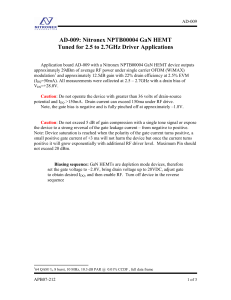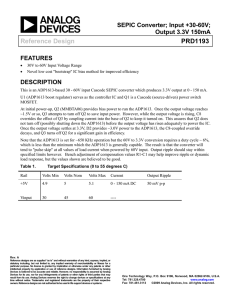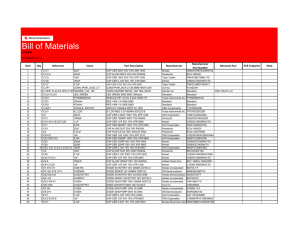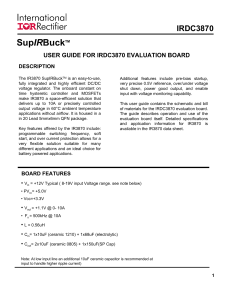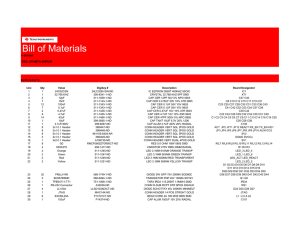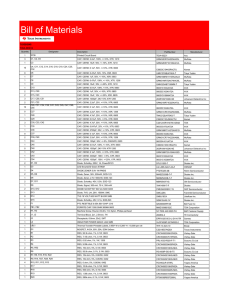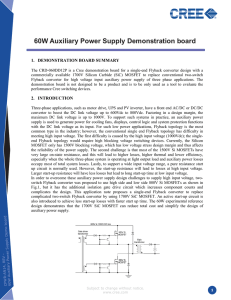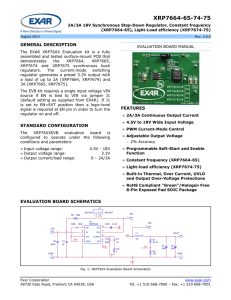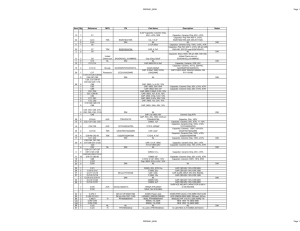AN-1931 LM25088 Evaluation Board (Rev. D)
advertisement
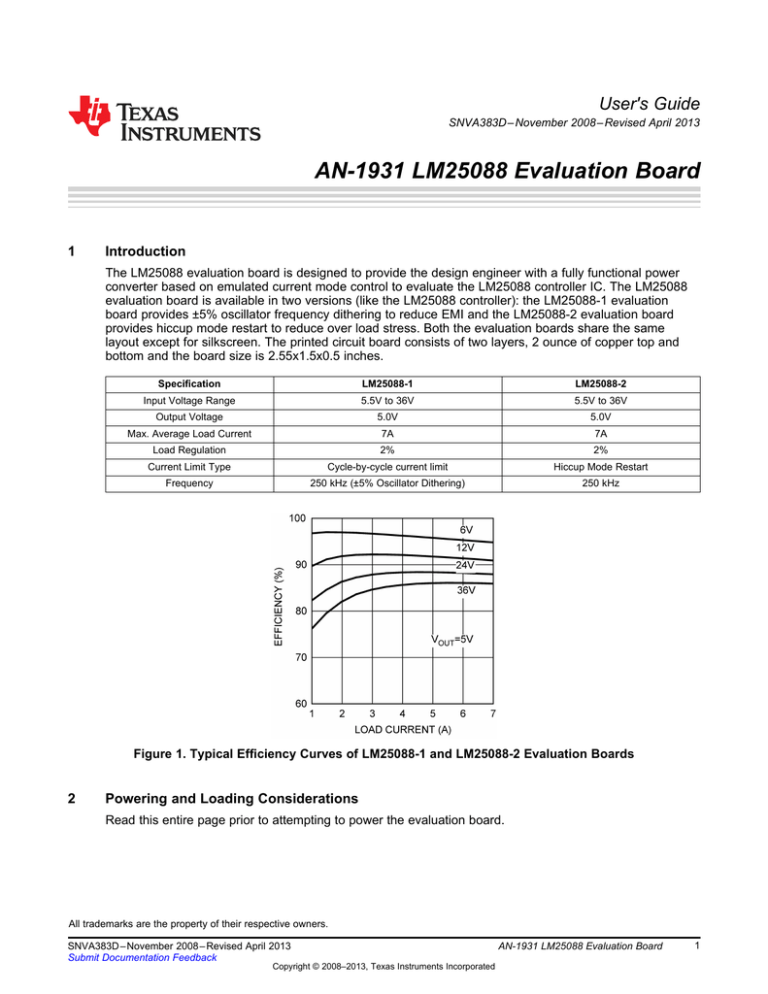
User's Guide SNVA383D – November 2008 – Revised April 2013 AN-1931 LM25088 Evaluation Board 1 Introduction The LM25088 evaluation board is designed to provide the design engineer with a fully functional power converter based on emulated current mode control to evaluate the LM25088 controller IC. The LM25088 evaluation board is available in two versions (like the LM25088 controller): the LM25088-1 evaluation board provides ±5% oscillator frequency dithering to reduce EMI and the LM25088-2 evaluation board provides hiccup mode restart to reduce over load stress. Both the evaluation boards share the same layout except for silkscreen. The printed circuit board consists of two layers, 2 ounce of copper top and bottom and the board size is 2.55x1.5x0.5 inches. Specification LM25088-1 LM25088-2 Input Voltage Range 5.5V to 36V 5.5V to 36V Output Voltage 5.0V 5.0V Max. Average Load Current 7A 7A Load Regulation 2% 2% Current Limit Type Cycle-by-cycle current limit Hiccup Mode Restart Frequency 250 kHz (±5% Oscillator Dithering) 250 kHz Figure 1. Typical Efficiency Curves of LM25088-1 and LM25088-2 Evaluation Boards 2 Powering and Loading Considerations Read this entire page prior to attempting to power the evaluation board. All trademarks are the property of their respective owners. SNVA383D – November 2008 – Revised April 2013 Submit Documentation Feedback Copyright © 2008–2013, Texas Instruments Incorporated AN-1931 LM25088 Evaluation Board 1 Powering and Loading Considerations 2.1 www.ti.com Quick Setup Procedure 1. Set the power supply current limit to 10A. Turn off the power supply. Connect the power supply to the VIN terminals. 2. Connect the load, with a 7A capability, to the VOUT terminals. 3. Slowly increase the load while monitoring the output, VOUT should be in regulation with a nominal 5V output. 4. Slowly sweep the input voltage from 5.5V to 36V, VOUT should remain in regulation with a nominal 5V output 5. Temporarily short the EN pin to check the shutdown function, Also, EN pin can be set between 0.4V and 1.2V, for example, by shorting EN pin to ground with a diode, to check the standby function. 6. Increase the load beyond the rated current to check the current limiting. The output current should limit at approximately 10A. The LM25088-1 board will enter cycle-by-cycle current limiting, while LM25088-2 is configured for a hiccup mode restart. Cooling is critical in this step. 2.2 Air Flow Prolonged operation with high input voltage (>24V) at full load will cause the LM25088 and MOSFETs to overheat and could potentially result in thermal shutdown. A fan with a minimum of 100LFM should always be used to cool the LM25088 evaluation board. 2.3 Powering Up It is suggested that the load be kept low during the first power up. Set the current limit of the source supply to provide about 1.5 times the anticipated wattage of the load. A quick efficiency check is the best way to confirm that everything is operating properly. If something is amiss one can be reasonably sure that it will affect the efficiency adversely. Few parameters can be correct in a switching power supply without creating losses and potentially damaging heat. 2.4 Over Current Protection The LM25088-1 and LM25088-2 evaluation boards are both configured with over-current protection schemes. The LM25088-1 employs a cycle-by-cycle current limiting, while the LM25088-2 is configured for a hiccup mode restart. Please refer the LM25088/LM25088Q Wide Input Range Non-Synchronous Buck Controller (SNVS609) data sheet for more information on RES pin. 2.5 Synchronization A Sync pin has been provided on the evaluation board. This pin can be used to synchronize the LM25088 to an external clock. It is recommended not to exceed 500 kHz while synchronizing. Refer the LM25088 datasheet for complete information. 2.6 Active Loads When using electronic load, it is strongly recommended to power up the evaluation board at light load and then slowly increase the load. This is necessary as most of the electronic loads do not draw any current till the output reaches an internally set point; this can result in soft-start function to not work as desired and can trip the current sense comparator. Electronic loads, in general, are best suited for monitoring steady state waveforms. If it is desired to power up the evaluation board at maximum load, resistor banks can be used. This will ensure a soft-start and evaluation board will perform as desired. Ensure that there is sufficient cooling for both the resistor banks and the LM25088 evaluation board, while running at full load. 2 AN-1931 LM25088 Evaluation Board SNVA383D – November 2008 – Revised April 2013 Submit Documentation Feedback Copyright © 2008–2013, Texas Instruments Incorporated www.ti.com Typical Performance Waveforms of LM25088-1 and LM25088-2 Evaluation Boards Figure 2. Typical Thermal Profile at 48VIN 3 Typical Performance Waveforms of LM25088-1 and LM25088-2 Evaluation Boards Conditions: Input Voltage = 24VDC Output Current = 4A to 7A Bandwidth Limit = 20 MHz Traces: Bottom Trace: Output Current Amps/div = 2A Top Trace: Output Voltage response Volts/div = 100 mV Horizontal Resolution = 500 µs/div Figure 3. Transient Response SNVA383D – November 2008 – Revised April 2013 Submit Documentation Feedback Copyright © 2008–2013, Texas Instruments Incorporated AN-1931 LM25088 Evaluation Board 3 Typical Performance Waveforms of LM25088-1 and LM25088-2 Evaluation Boards www.ti.com Conditions: Input Voltage = 24VDC Output Current = 7A Trace: Output Voltage Volts/div = 1V Figure 4. Soft-Start Conditions: Input Voltage = 24VDC Output Current = 7A Bandwidth Limit = 20 MHz Trace: Output Ripple Volts/div = 50 mV Horizontal Resolution = 5.0 µs/div Figure 5. Output Voltage Ripple Figure 6. Conducted Emissions Measured at the Input of a LM25088-1 Evaluation Board 4 AN-1931 LM25088 Evaluation Board SNVA383D – November 2008 – Revised April 2013 Submit Documentation Feedback Copyright © 2008–2013, Texas Instruments Incorporated www.ti.com Typical Performance Waveforms of LM25088-1 and LM25088-2 Evaluation Boards Figure 7. LM25088-1 W/Dithering Schematic Figure 8. LM25088-2 W/Restart Schematic SNVA383D – November 2008 – Revised April 2013 Submit Documentation Feedback Copyright © 2008–2013, Texas Instruments Incorporated AN-1931 LM25088 Evaluation Board 5 Bill of Materials for LM25088-1 and LM25088-2 Evaluation Boards 4 6 www.ti.com Bill of Materials for LM25088-1 and LM25088-2 Evaluation Boards Part Value Package Manufacturer Manufacturer Part Number Description C1,C2,C3, C4,C5 2.2 µF C1210 Murata GRM32ER72A225KA35L CAP CER 2.2 µF 100V X7R 1210 C6,C19 0.1 µF C0805 TDK Corporation C2012X7R2A104K CAP CER .10 µF 100V X7R 10% 0805 C7 1 µF C0603 Murata GRM188R71C105KA12D CAP CER 1 µF 16V X7R 0603 C8,C11 100 pF C0603 AVX Corporation 06031A101FAT2A CAP CERM 100 pF 1% 100V NP0 0603 C9 270 pF C0603 Murata GRM1885C2A271JA01D CAP CER 270 pF 100V 5% C0G 0603 C13 0.1 µF C0603 Murata GRM188R72A104KA35D CAP CER .1 µF 100V X7R 0603 C10 0.022 µF C0603 Murata GRM188R71C223KA01D CAP CER 22000 pF 16V 10% X7R 0603 C12 0.015 µF C0603 Murata GRM188R71H153KA01D CAP CER 15000 pF 50V 10% X7R 0603 C15 470 µF 0.327x0.327x0.3 03 Nippon-Chemicon APXF6R3ARA471MH80G CAP 470 µF 6.3V ELECT POLY SMD C17,C18 47 µF C1210 Murata GRM32ER61A476KE20L CAP CER 47 µF 10V X5R 1210 C20 1000 pF C0805 Murata GRM2195C2A102JA01D CAP CER 1000 pF 100V 5% C0G 0805 C16 NU 0.327x0.327x0.3 03 NU NU NU C21 NU C0603 NU NU NU C14 (LM25088 -1) 0.1 µF C0603 Murata GRM188R72A104KA35D CAP CER .1 µF 100V X7R 0603 C14 (LM25088 -2) 0.022 µF C0603 Murata GRM188R71C223KA01D CAP CER 22000 pF 16V 10% X7R 0603 D1 Schottky Diode D2PAK On Semi MBRB1545CT Schottky Rectifiers 15A 45V D2 NU SOD123 NU NU NU L1 6.8 µH HC9 series Coiltronics HC9-6R8-R INDUCTOR HIGH CURRENT 6.8 µH Q1 MOSFET SO-8 Vishay IR SI7848DP MOSFET N-CH 40V PWR PAK SO8 R1 54.9 kΩ R0805 Rohm MCR10EZHF5492 RES 54.9 kΩ 1/8W 1% 0805 SMD R2 16.2 kΩ R0603 Rohm MCR03EZPFX1622 RES 16.2 kΩ 1/10W 1% 0603 SMD R3 24.9 kΩ R0603 Rohm MCR03EZPFX2492 RES 24.9 kΩ 1/10W 1% 0603 SMD R4 18.2 kΩ R0603 Rohm MCR03EZPFX1822 RES 18.2 kΩ 1/10W 1% 0603 SMD R5 10 mΩ R0815 Susumu Co Ltd RL3720WT-R010-F RES .01Ω 1W 1% 0815 SMD R6 5.1Ω R2512 Panasonic - ECG ERJ-1TRQF5R1U RES 5.1Ω 1W 1% 2512 SMD R7 10Ω R0805 Rohm MCR10EZHF10R0 RES 10.0Ω 1/8W 1% 0805 SMD R8 5.11 kΩ R0603 Rohm MCR03EZPFX5111 RES 5.11 kΩ 1/10W 1% 0603 SMD RES 1.62 kΩ 1/10W 1% 0603 SMD R9 1.62 kΩ R0603 Rohm MCR03EZPFX1621 R10 NU R0603 NU NU NU J1,J2,J3, J4 Terminal_ Turret Keystone 1509 Terminal, Turret TP1,TP2 Slotted test point Keystone 1040 Terminal test point slotted U1 PWM IC Texas Instruments LM25088-1/LM25088-2 ECM Buck Controller TSSOP16_EP AN-1931 LM25088 Evaluation Board SNVA383D – November 2008 – Revised April 2013 Submit Documentation Feedback Copyright © 2008–2013, Texas Instruments Incorporated PCB Layout www.ti.com 5 PCB Layout Figure 9. LM25088-1 and LM25088-2 Top Layer Figure 10. LM25088-1 and LM25088-2 Bottom Layer SNVA383D – November 2008 – Revised April 2013 Submit Documentation Feedback Copyright © 2008–2013, Texas Instruments Incorporated AN-1931 LM25088 Evaluation Board 7 PCB Layout www.ti.com Figure 11. LM25088-2 Silk Screen Figure 12. LM25088-1 Silk Screen 8 AN-1931 LM25088 Evaluation Board SNVA383D – November 2008 – Revised April 2013 Submit Documentation Feedback Copyright © 2008–2013, Texas Instruments Incorporated IMPORTANT NOTICE Texas Instruments Incorporated and its subsidiaries (TI) reserve the right to make corrections, enhancements, improvements and other changes to its semiconductor products and services per JESD46, latest issue, and to discontinue any product or service per JESD48, latest issue. Buyers should obtain the latest relevant information before placing orders and should verify that such information is current and complete. All semiconductor products (also referred to herein as “components”) are sold subject to TI’s terms and conditions of sale supplied at the time of order acknowledgment. TI warrants performance of its components to the specifications applicable at the time of sale, in accordance with the warranty in TI’s terms and conditions of sale of semiconductor products. Testing and other quality control techniques are used to the extent TI deems necessary to support this warranty. Except where mandated by applicable law, testing of all parameters of each component is not necessarily performed. TI assumes no liability for applications assistance or the design of Buyers’ products. Buyers are responsible for their products and applications using TI components. To minimize the risks associated with Buyers’ products and applications, Buyers should provide adequate design and operating safeguards. TI does not warrant or represent that any license, either express or implied, is granted under any patent right, copyright, mask work right, or other intellectual property right relating to any combination, machine, or process in which TI components or services are used. Information published by TI regarding third-party products or services does not constitute a license to use such products or services or a warranty or endorsement thereof. Use of such information may require a license from a third party under the patents or other intellectual property of the third party, or a license from TI under the patents or other intellectual property of TI. Reproduction of significant portions of TI information in TI data books or data sheets is permissible only if reproduction is without alteration and is accompanied by all associated warranties, conditions, limitations, and notices. TI is not responsible or liable for such altered documentation. Information of third parties may be subject to additional restrictions. Resale of TI components or services with statements different from or beyond the parameters stated by TI for that component or service voids all express and any implied warranties for the associated TI component or service and is an unfair and deceptive business practice. TI is not responsible or liable for any such statements. Buyer acknowledges and agrees that it is solely responsible for compliance with all legal, regulatory and safety-related requirements concerning its products, and any use of TI components in its applications, notwithstanding any applications-related information or support that may be provided by TI. Buyer represents and agrees that it has all the necessary expertise to create and implement safeguards which anticipate dangerous consequences of failures, monitor failures and their consequences, lessen the likelihood of failures that might cause harm and take appropriate remedial actions. Buyer will fully indemnify TI and its representatives against any damages arising out of the use of any TI components in safety-critical applications. In some cases, TI components may be promoted specifically to facilitate safety-related applications. With such components, TI’s goal is to help enable customers to design and create their own end-product solutions that meet applicable functional safety standards and requirements. Nonetheless, such components are subject to these terms. No TI components are authorized for use in FDA Class III (or similar life-critical medical equipment) unless authorized officers of the parties have executed a special agreement specifically governing such use. Only those TI components which TI has specifically designated as military grade or “enhanced plastic” are designed and intended for use in military/aerospace applications or environments. Buyer acknowledges and agrees that any military or aerospace use of TI components which have not been so designated is solely at the Buyer's risk, and that Buyer is solely responsible for compliance with all legal and regulatory requirements in connection with such use. TI has specifically designated certain components as meeting ISO/TS16949 requirements, mainly for automotive use. In any case of use of non-designated products, TI will not be responsible for any failure to meet ISO/TS16949. Products Applications Audio www.ti.com/audio Automotive and Transportation www.ti.com/automotive Amplifiers amplifier.ti.com Communications and Telecom www.ti.com/communications Data Converters dataconverter.ti.com Computers and Peripherals www.ti.com/computers DLP® Products www.dlp.com Consumer Electronics www.ti.com/consumer-apps DSP dsp.ti.com Energy and Lighting www.ti.com/energy Clocks and Timers www.ti.com/clocks Industrial www.ti.com/industrial Interface interface.ti.com Medical www.ti.com/medical Logic logic.ti.com Security www.ti.com/security Power Mgmt power.ti.com Space, Avionics and Defense www.ti.com/space-avionics-defense Microcontrollers microcontroller.ti.com Video and Imaging www.ti.com/video RFID www.ti-rfid.com OMAP Applications Processors www.ti.com/omap TI E2E Community e2e.ti.com Wireless Connectivity www.ti.com/wirelessconnectivity Mailing Address: Texas Instruments, Post Office Box 655303, Dallas, Texas 75265 Copyright © 2013, Texas Instruments Incorporated
